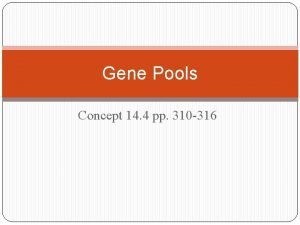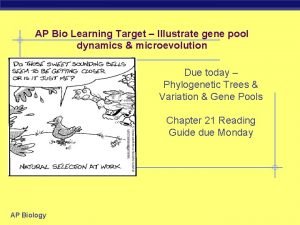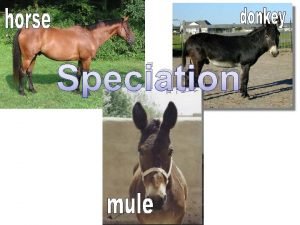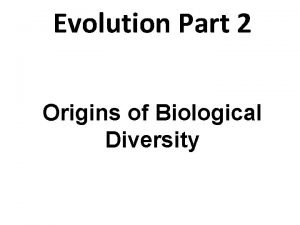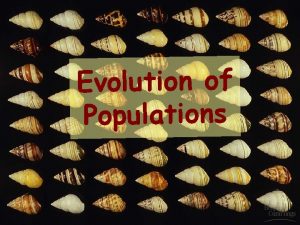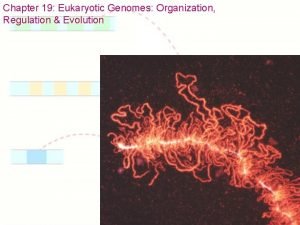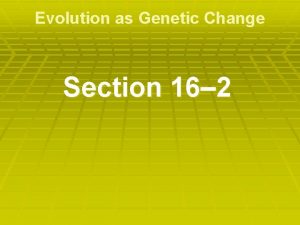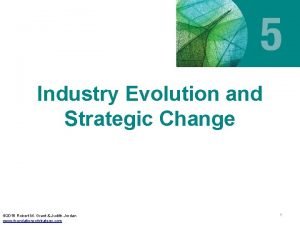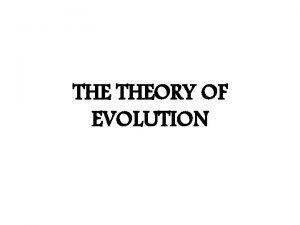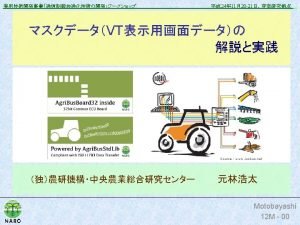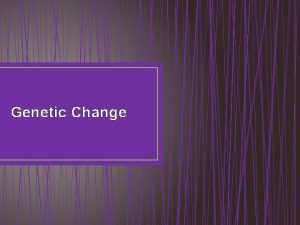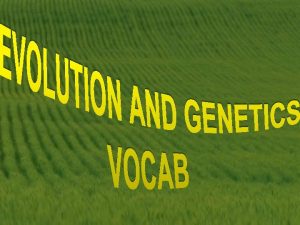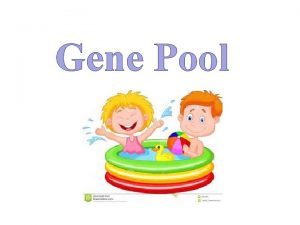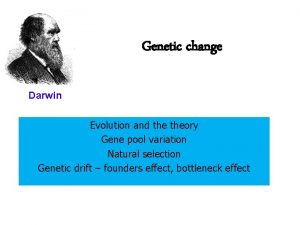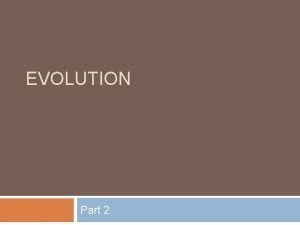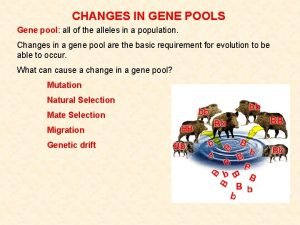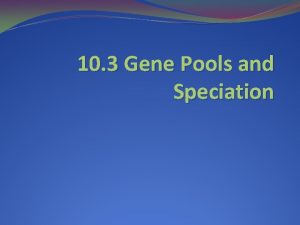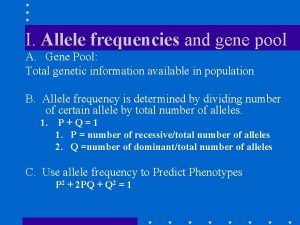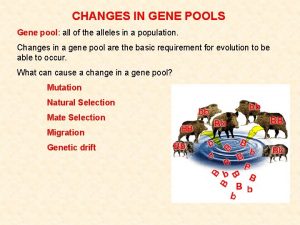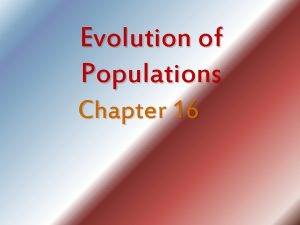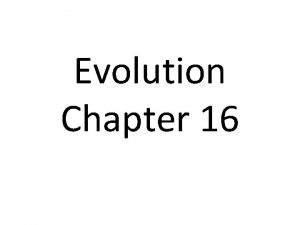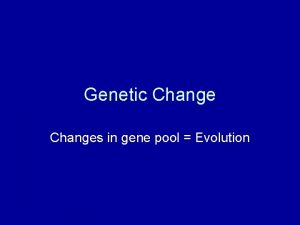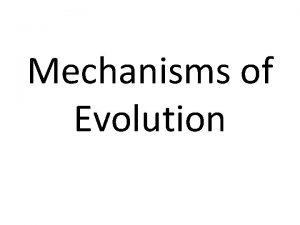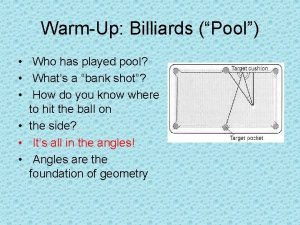EVOLUTION Evolution Change in the gene pool of





























- Slides: 29

EVOLUTION

Evolution • Change in the gene pool of a population that results in successful change over time • Evolution can happen in various ways.

Change over time? 4. 6 billion years ago : Earth formed 3. 4 b-Prokaryotes 2. 1 b-Eukaryotes 543 million years ago: multicellular organisms appear • 200 million- first mammals • 200 000 – first modern humans • •

Change over time?

Recombination • The process by which genetic material from different individuals becomes combined. • Gene recombination during meiosis • Sexual reproduction

Gene Flow • The movement of genes into and out of a population due to interbreeding between different populations.

Genetic Drift • Random changes in the frequency of alleles within a gene pool; greater effect on small populations.

Mutation • Any change in the sequence of DNA; they can be beneficial, neutral, or harmful.

Natural Selection • Mechanism by which individuals that have inherited beneficial adaptations produce more offspring. • Idea proposed by Charles Darwin and Alfred Wallace

Charles Darwin • Traveled around the world between 1831 -1836 • Collected and made many observations on the species he encountered, especially the various Galapagos islands. • Was credited for the idea of evolution by natural selection.

Mechanism of Natural Selection 1. Overpopulation • more individuals born than can survive

2. Competition • for limited resources • some will survive, some will not

3. Variation • differences among individuals • a result of genetic mutation – changes in DNA

4. Adaptation (or not) • some variation gives some individuals a slight survival advantage

5. Reproduction (Descent with Modification) • those with best traits survive, reproduce and pass favorable traits on to their offspring

• Species alive today are descendent with modifications from common ancestors.

Types of Evolution • Divergent Evolution: Process by which an interbreeding species diverges into 2 or more species.

Types of Evolution • Convergent Evolution: Two unrelated species independently evolve similar traits.

Types of Evolution • Co-Evolution: Evolution of 2 or more species, each adapting to changes in the other.

Types of Evolution • Microevolution: small-scale changes, change in allele(no change in kind of organisms) • Macroevolution: largescale changes, can lead to evolution of new species and groups(change in kind of organisms)

Changes and the Fossil Record • • Gradualism: evolution generally occurs uniformly and by the steady and gradual transformation Punctuated equilibrium: theory that speciation occurs in spurts of major genetic alterations that punctuate long periods of little change • Adaptive Radiation: Diversification of a species or single ancestral type into several forms that are each adaptively specialized to a specific environment

Changes and Fossil Records • Fossil Record: history of life as documented by fossils. • Sudden Appearance: organisms appear abruptly in the fossil record. • Stasis: period without change in the fossil record • Sequential nature: gradual change in fossils

Evidence of Common Ancestry Cellular and Molecular 1 -Cell Theory • Cell is basic unit of life • Every life form is made of this basic structure 2 -Organic Molecules • 99% of all life is made of carbon, hydrogen, oxygen, nitrogen, phosphorous, & sulfur • Common usage of a small subset of over 90 available elements for living things

Evidence of Common Ancestry Cellular and Moleculare 3 -DNA • Genetic informational molecule in every organism, including viruses • DNA language (genetic code) is universal • Common genetic language allows for insertion of human genes in bacteria to produce human proteins 4 -ATP primary energy molecule for every organism

Evidence of Common Ancestry Natural Selection 1 -Artificial selection • Humans have selected (breed) animals for certain characteristics (looks, number of eggs produced, wheat yields) 2 -Biogeography – geographic distribution of species can show organisms are related • Flightless birds found in Africa, South American, and Australia. It is thought that all 3 had a common ancestor before the tectonic plates moved (continental drift) • Marsupial mammals – this concept explains why they developed in Australia (separated from placental mammals found on other continents)

Evidence of Common Ancestry Natural Selection 3 -Fossils – preserved remains of dead organisms • Paleontologist - is the study of prehistoric life, includes the study of fossils • Darwin termed evolution “descent with modification” • Fossil records provide valuable information about evolutionary changes or modifications in organisms • Estimate age of fossil by location in sedimentary rock (relative dating) and radiometric isotope techniques (absolute dating) • Molecular clocks – look at changes in portions of genomes of organisms; also used to help determine the age of evolutionary events

Evidence of Common Ancestry 4 -Homologies (Homologous Structures) • Anatomical similarities of related life forms • Example: forelimbs of vertebrates made of same basic bones but have different functions based on environment 5 -Vestigial structures – are the remains of non -functional structures Example – pelvic bones in modern whales and snakes

Evidence of Evolution 6 -Analogous structures - Some biological characteristics are analogous (also called "convergent"), which means that they serve the same function in different species but they evolved independently rather than from the same embryological material or from the same structures in a common ancestor. An example of an analogous structure would be the wings on butterflies, bats, and birds.

Evidence of Evolution 7 -Variations in Life • In England, the peppered moth shifted from predominantly light coloring to dark when air pollution darkened the trees that it lives on 8 -Comparative anatomy of adults – visual similarities in adult vertebrate (eyes, ears, mouth, nose, appendages 9 -Comparative embryology – early developmental stages of humans share remarkably similar vertebrate characteristics that either disappear or become vestigial in human adults •
 What is gene pool
What is gene pool Gene pool ap bio
Gene pool ap bio Genetic drift vs genetic flow
Genetic drift vs genetic flow Temporal isolation
Temporal isolation Individuals don't evolve populations do
Individuals don't evolve populations do The founder effect
The founder effect Gene pool
Gene pool Gene pool adalah
Gene pool adalah Gene by gene test results
Gene by gene test results Chapter 17 gene expression from gene to protein
Chapter 17 gene expression from gene to protein Gene evolution
Gene evolution Section 16-2 evolution as genetic change
Section 16-2 evolution as genetic change Industry evolution and strategic change
Industry evolution and strategic change Slow evolution
Slow evolution Hình ảnh bộ gõ cơ thể búng tay
Hình ảnh bộ gõ cơ thể búng tay Frameset trong html5
Frameset trong html5 Bổ thể
Bổ thể Tỉ lệ cơ thể trẻ em
Tỉ lệ cơ thể trẻ em Gấu đi như thế nào
Gấu đi như thế nào Thang điểm glasgow
Thang điểm glasgow Chúa yêu trần thế alleluia
Chúa yêu trần thế alleluia Môn thể thao bắt đầu bằng từ đua
Môn thể thao bắt đầu bằng từ đua Thế nào là hệ số cao nhất
Thế nào là hệ số cao nhất Các châu lục và đại dương trên thế giới
Các châu lục và đại dương trên thế giới Công của trọng lực
Công của trọng lực Trời xanh đây là của chúng ta thể thơ
Trời xanh đây là của chúng ta thể thơ Cách giải mật thư tọa độ
Cách giải mật thư tọa độ Phép trừ bù
Phép trừ bù Phản ứng thế ankan
Phản ứng thế ankan Các châu lục và đại dương trên thế giới
Các châu lục và đại dương trên thế giới
